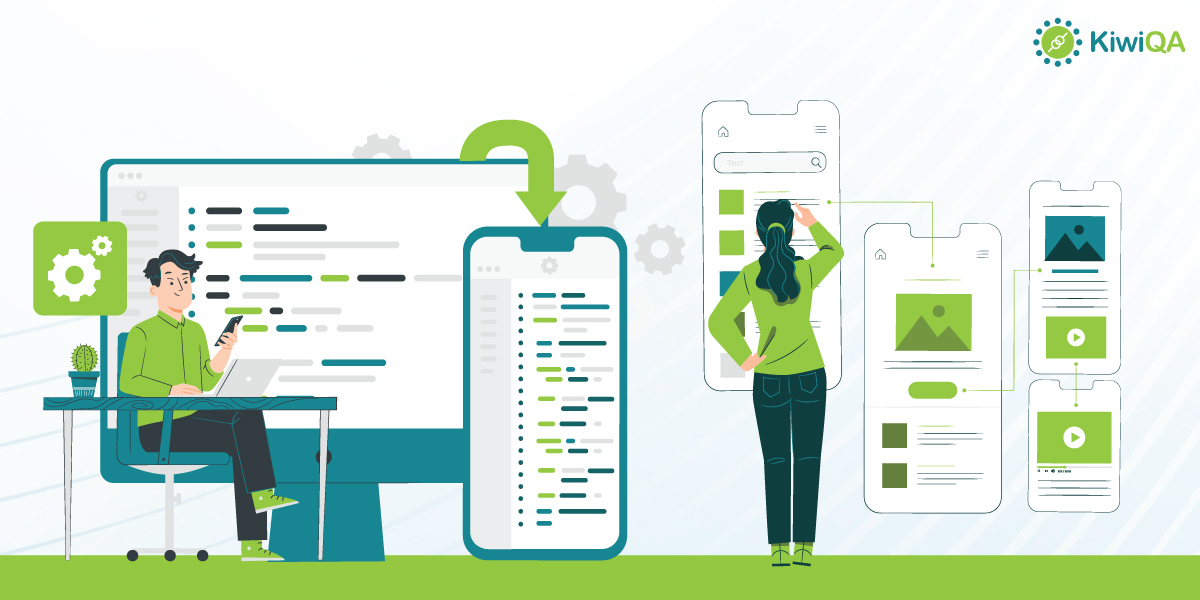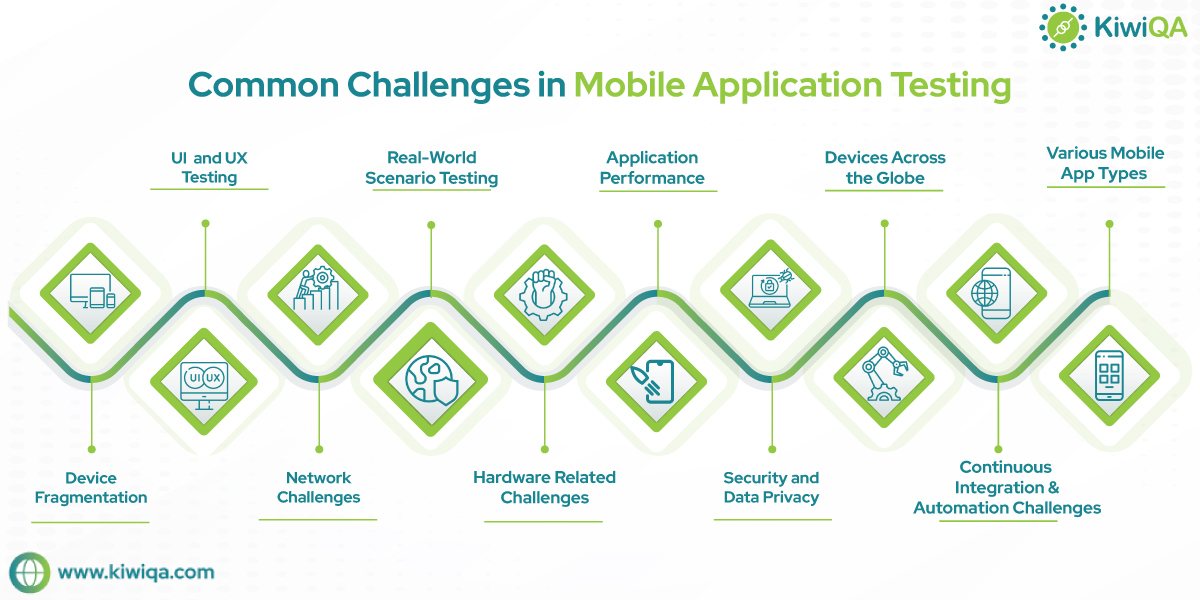Mobile application testing is crucial in today’s digitally-connected world, as mobile devices serve as the gateway to various services. A recent study has shown that consumers are spending over five to six hours daily using mobile apps, and the global user’s app engagement rate increased by approximately 46% between 2019 and 2022. These statistics obviously increased the demand for app services in almost all industries.
From small to large, organizations have started investing more in mobile app development projects. Therefore, there is a growing demand for a more efficient mobile device testing approach. However, with the evolving mobile ecosystem, a lot of challenges are faced in mobile application testing services to ensure the app is fully optimized to not jeopardize customer and client service data.
The top challenges in mobile application testing include diverse devices, operating systems, and user expectations. Follow through this guide to explore all these mobile testing challenges for native applications that highlight the difficulties programmers and testers have to overcome to ensure the reliability and smooth operation of native mobile apps.
Mobile application testing services has become very necessary as users demand flawless experiences across multiple devices. Developers and testers can navigate the evolving mobile landscape confidently, ensuring their apps meet the exacting standards of today’s evolving customer behavior as they understand and address these testing challenges.
Importance of Mobile Application Testing
In the software development lifecycle, developers rely heavily on mobile application testing professionals as they have expertise in ensuring the app is operating seamlessly across various devices, network conditions, and operating systems. Consumers have high expectations from mobile apps to offer them services without manual work.
So, the testing process serves as a security procedure to prevent potential disasters like app crashes, data breaches, and user frustrations. Any app functionality or operation failure can damage the client’s brand reputation and lead to financial losses in the long run. Moreover, mobile application testing solutions also help in identifying and addressing performance constrictions, compatibility issues, or usability problems before the app launch.
In the competitive app market, a single negative experience can lead to app abandonment. Therefore, addressing common challenges in mobile application testing is not just a box to be checked but a strategic imperative for businesses to create loyal and satisfied customer bases. It is a key basis for delivering mobile applications that meet and exceed user expectations, ultimately driving success in the digital landscape.
Also Read: Why Solid Mobile App Testing Strategy is Crucial?
What are the main challenges of mobile application testing?
It’s essential to know what are the main challenges of mobile application testing to ensure the app will launch flawlessly. Due to the dynamic and diverse nature of today’s mobile ecosystem, the main challenges of mobile application testing arise. These challenges require continuous testing, user interface testing, security testing, performance optimization, and a balance between manual and automated testing to ensure data launch. Here are the key aspects that make mobile application testing challenging:
Top 10 Common Challenges in Mobile Application Testing
1. Device Fragmentation
One of the principal challenges in mobile application testing is the growing number of mobile manufacturers producing different models. With countless device models, screen sizes, resolutions, and OS versions, ensuring compatibility across the vast array of mobile devices is a significant challenge. Each manufacturer comes with unique hardware specifications.
A mobile app needs to be configured according to a mobile device model to meet that user segment’s needs. Hence, testers have to test the app across various mobile brands like Samsung, Apple, etc., with more attention to detail. Moreover, the app’s layout, visual appeal, and functionality depend on the mobile device screen sizes, from small smartphones to big tablets. Hence, the different screens and resolution ranges are also big challenges.
Multiple versions of operating systems like Android and iOS coexist, each with its own set of features, behaviors, and potential bugs. Additionally, device manufacturers often customize these OS versions, introducing further complexities in testing. These OS customizations can impact app performance and compatibility and require tailored testing solutions.
2. User Interface (UI) and User Experience (UX) Testing
Every mobile app development lifecycle prioritizes UI and UX. Hence, UX and UI testing is critical in mobile app testing. It involves a series of processes to evaluate the app’s layout, design, and user-friendliness to make seamless interaction with the users. The design variability contributes to mobile application testing challenges, with UI elements differing across various devices and screen sizes. Detailed testing is required to ensure the app’s design element adapts appropriately to each device without layout and rendering issues that can affect usability.
Mobile devices rely heavily on touchscreens for user interaction, introducing complexities in testing multi-touch gestures, swipe actions, pinch-to-zoom, and more. Moreover, it is crucial to test the app’s ability to adapt to screen orientation from portrait to landscape and vice versa without compromising usability. These are some significant challenges faced while testing mobile applications to ensure these functionalities work flawlessly on all devices.
3. Network Challenges
Among the common challenges in mobile application testing, addressing network-related issues is the most important. Mobile devices can connect to a range of network types, including 3G, 4G, 5G, and Wi-Fi, each with its own speed and reliability characteristics. Since mobile apps rely heavily on network connectivity for data exchange and ensuring a seamless experience across various network types and speeds, they pose significant challenges. Moreover, mobile devices frequently transition between different networks as users move around. This aspect also requires testing to ensure network transition without data loss or crashes.
Different carriers may introduce unique challenges. Service interruptions, network congestion, and carrier-specific restrictions can affect app performance. Additionally, roaming and cross-network testing are essential to ensure that the app functions correctly when users travel and switch between carriers.
4. Hardware-Related Challenges
Mobile application testing faces unique challenges tied to the wide array of hardware components and external device interactions found in mobile devices. There are various hardware components in mobile devices, such as cameras, GPS, microphones, sensors, etc. This will further require testing across various devices and brands to ensure the app functions correctly and utilizes these hardware features effectively. Furthermore, testing for power efficiency is crucial to prevent excessive battery drain and ensure that the app does not affect device performance.
Mobile apps often interact with external hardware devices via technologies like Bluetooth, NFC, and USB connections. Ensuring compatibility and functionality with these external devices is a challenge, as it again requires testing across a range of devices and scenarios.
5. Real-World Scenario Testing
Real-world scenario evaluation is vital for mobile application testing solutions because it captures the genuine user experience. It involves location-based testing to ensure accurate location information and GPS features. Apart from that, interrupt testing helps in assessing how the app handles interruptions like calls, messages, and notifications. This testing goes beyond functional testing to ensure app stability in dynamic environments to build a user-friendly mobile app.
6. Application Performance
Application performance testing involves load and stress testing, which evaluates the app’s response to high usage. It’s challenging to conduct stress testing to identify potential bottlenecks or app crashes that ensure the app’s scalability. Moreover, memory and CPU consumption testing is essential for efficient resource management in the app development process.
7. Security and Data Privacy
Another challenging aspect of mobile application testing is assessing vulnerability to ensure data encryption and secure connections. Testers simulate attacks and scrutinize the app’s code to identify potential flaws. They also assess the app’s handling of permissions, ensuring proper communication protocols and encryption. The testers use penetration testing and dynamic analysis tools techniques that ensure user data remains confidential to ensure the app remains resilient against security threats.
Also Read: Mobile App Testing Techniques: Ensuring App Excellence
8. Continuous Integration and Automation Challenges
The mobile testing process can be challenging due to continuous integration and automation during the app development process. However, it is a crucial step to ensure faster time to market. Therefore, choosing the right tools is essential, considering ease of use, compatibility with the app’s technology stack, and handling different types of tests. Moreover, maintaining test scripts is also a challenge, as mobile apps often undergo frequent updates. To overcome these, teams need a robust strategy for tool selection and adopt a version control system.
9. Too Many Devices working on Globally
Testers and developers should be aware of what are the common challenges in mobile application testing to optimize the app for the global market. The global mobile device market is a complex landscape for mobile application testing, with diverse manufacturers like Apple, Samsung, and Huawei dominating the market. Testing apps across these manufacturers requires careful attention to ensure compatibility. Hardware capabilities vary among devices due to varied screen sizes, resolutions, and other aspect ratios. So, responsive design testing is necessary to ensure consistent user experiences.
10. Many Types & Tools Of Mobile Applications
Due to multiple versions of operating systems in mobile devices, the testing process becomes complicated. Customized OS variants by different manufacturers on a global level further complicate the process. These challenges can only be addressed through comprehensive testing on a representative subset of devices, a mix of manual and automated testing, and the use of emulators and simulators.
-
Different types of Mobile Applications
There are various forms of mobile applications, which include those built for specific OS platforms like iOS and Android. You can also develop mobile apps using web technologies like HTML, CSS, JavaScript, etc., that offer cross-platform compatibility. Some apps can blend native and web app traits. Furthermore, you can use frameworks like Cordova and Ionic for hybrid app development. These can lead to challenges in ensuring consistent functionality across different operating systems, various browsers, and compatibility issues.
-
Tools for Mobile Applications
For Android app development, developers commonly use Android Studio and Eclipse. Frameworks such as React Native, Xamarin, and Flutter simplify hybrid app development by enabling developers to build applications for various platforms from one codebase. It will require additional testing to ensure the development codes work seamlessly within development environments.
-
Testing Tools
Testing mobile apps requires a suite of tools. Automated testing tools like Appium, Espresso, and XCUITest assist in functional testing. Tools like JMeter and LoadRunner are instrumental in assessing an app’s performance under different scenarios, leading to improved user satisfaction. These tools can have a steep learning curve and require ongoing maintenance to keep tests relevant with app updates.
Experience Seamless Mobile App Testing: Test Today!
The guide provides you with a comprehensive overview of the top 10 mobile app testing challenges the technical team faces. However, emphasizing the importance of ongoing investigation and seeking help for each unique challenge is crucial for creating successful mobile applications.
In today’s digital landscape, with increasing user expectations and diverse devices, it’s essential to have a comprehensive approach, whether developing for iOS, Android, or hybrid platforms or blending native and web elements. Use mobile application testing services for a hassle-free journey with your app development lifecycle. So, test your app today to guarantee user satisfaction.








